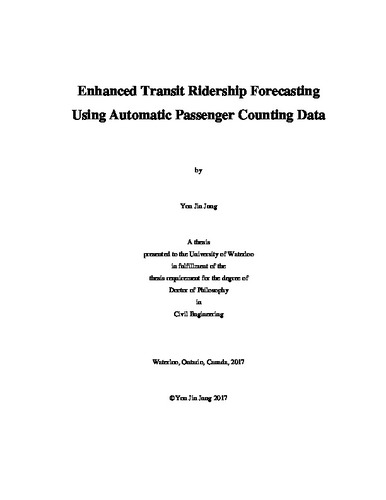| dc.contributor.author | Jung, You Jin | |
| dc.date.accessioned | 2017-04-07 15:19:00 (GMT) | |
| dc.date.available | 2017-08-06 04:50:08 (GMT) | |
| dc.date.issued | 2017-04-07 | |
| dc.date.submitted | 2017 | |
| dc.identifier.uri | http://hdl.handle.net/10012/11642 | |
| dc.description.abstract | Recent emphasis on sustainable development has carried over into the transportation sector, given the impacts of transportation behavior on environment and equity. Transit is widely recognized as a viable option supporting the sustainability issue providing benefits such as reducing air pollution, alleviating traffic congestion, enhancing mobility, and promoting social well-being (health through walk- and bike-access). An important tool in advancing sustainable transport is to generate more robust transit ridership models to evaluate the benefits of investments in these modes. In particular, this thesis concentrates on two sub-problems of (1) calibration procedures and (2) insufficient data for transit mode choice modules.
The first purpose of this thesis is to improve the calibration procedures through better understanding of calibrated mode constants. First, the magnitude and relative importance of mode constants to measurable components are analyzed using representative data from six cities in North America. The mode constants (representing unmeasured inputs) in study cities account for 41% to 65% of total utilities. The results demonstrate that, in some cases, mode constants are large enough to render models insensitive to changes of important but omitted system factors such as reliability, comfort, convenience, visibility, access environment, and safety. The need to explicitly include mode constant endogenous to the model is verified.
Second, this thesis introduces a framework to improve the utilization of new data sources such as automated vehicle location (AVL) and automated passenger counting (APC) systems in transit ridership forecasting models. The direct application of the AVL/APC data to travel forecasting requires an important intermediary step that links stops activities - boarding and alighting - to the actual location (at the TAZ level) that generated/attracted this trip. The GIS-based transit trip allocation methods are newly developed with focus on considering the case when the access shed spans multiple TAZs. The proposed methods improve practical applicability with easily obtained data in local contexts. The performance of the proposed allocation methods is further evaluated using transit on-board survey data. The results show that the buffer area ratio weighted by employment or population and footprint weighted method perform reasonably well in the study area and can effectively handle various conditions, particularly for major activity generators. The average errors between observed data and the proposed method are about 8% for alighting trips and 18% for boarding trips.
Third, given the outputs from the previous research effort, the application framework of the AVL/APC data to travel forecasting model calibration is demonstrated. In the proposed framework, transit trip allocation methods are employed to identify prediction errors at finer geographic level (at TAZs). In turn, the approach makes it possible to evaluate the zonal characteristics that affect estimation accuracy. Developed multinomial regression models produce equations for the mode choice prediction errors as a function of (1) measurable but omitted market segmentation variables in current mode choice utility function including socio-economic and land use data; and (2) newly quantifiable attributes with new data source or techniques including quality of service variables. The proposed composite index can systematically evaluate and prioritize the major source of prediction errors by quantifying total magnitudes of prediction error and a possible error component.
The outcomes of the research in this thesis can serve as foundation towards more reliable and accurate mode choice models and ultimately enhanced transit travel forecasting. | en |
| dc.language.iso | en | en |
| dc.publisher | University of Waterloo | en |
| dc.subject | mode choice prediction errors | en |
| dc.subject | AVL/APC data | en |
| dc.subject | GIS based method | en |
| dc.subject | mode constants / alternative specific constants | en |
| dc.subject | transit travel forecasting models | en |
| dc.title | Enhanced Transit Ridership Forecasting Using Automatic Passenger Counting Data | en |
| dc.type | Doctoral Thesis | en |
| dc.pending | false | |
| uws-etd.degree.department | Civil and Environmental Engineering | en |
| uws-etd.degree.discipline | Civil Engineering | en |
| uws-etd.degree.grantor | University of Waterloo | en |
| uws-etd.degree | Doctor of Philosophy | en |
| uws-etd.embargo.terms | 4 months | en |
| uws.contributor.advisor | Casello, Jeffrey | |
| uws.contributor.affiliation1 | Faculty of Engineering | en |
| uws.published.city | Waterloo | en |
| uws.published.country | Canada | en |
| uws.published.province | Ontario | en |
| uws.typeOfResource | Text | en |
| uws.peerReviewStatus | Unreviewed | en |
| uws.scholarLevel | Graduate | en |

